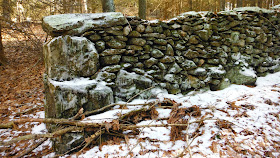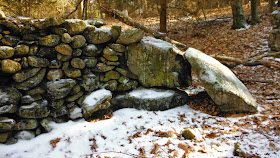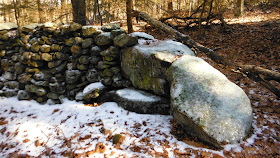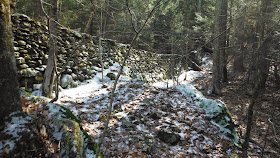After reading the something I'd never come across before, entitled "What Grampa Didn't Tell You," all I can say is
that I suppose it all depends on which “Grampa” you are listening to. One “Grampa”
might just be repeating what others have said over and over, but another “Grandpa”
may actually be looking back a little further than 1620 or that Great Age of
Stone Wall Building between the American Revolution and the Invention of Barbed
Wire and looking a little more closely, wondering, “Who was more likely to
include a stone, possibly humanly enhanced, and placed so as to resemble a bear
into a stone wall – an Indigenous Person or the later people who have only been
here for the last few hundred years?”
And another Grandpa might say to his 3 or 4 year old
grandchild, “Do you see the bear?”
That innocent little grandchild might point out the bear
shape right away (above photo).
And another Grandpa might look at that possible bear effigy
in stone from another angle and ask, “Do you want to see Grandpa turn a bear into a turtle?”
"Come over here, look again and tell me if you see a turtle."
"Another Grandpa" might take a second look at and start wondering perhaps why the big boulder at the end of a row of stones resembles a snake’s head.
And how another big boulder at the end of another row of stones resembles
another snake’s head – and continues finding that that snake head deal is true
of many more rows of stones commonly called stone walls - by almost everybody but Grandpa anyway...
(Grandpa
might say: “Stand right here so I can take a picture.” - and then, “Is that a snake?”)
That Other Grandpa
might say, “Hey, another Snake with his nose on that other snake!” – and walk
with that grandchild along that undulating body, both calling out the shapes in
the stones, such as triangles and diamonds, on the lookout for bears and turtles…
And when it’s just too far for 4 year old legs to travel, "Another Grandpa" might carry
the kid along the other side of that “another snake,” back along the far end of
that first snake to another gate, stop to take another picture, saying, "Stand on that Snake Head!" before going back to the parked car…
This is the bit of Thorson I came across that started this
line of thought:
“The letter from the stonemason asks Grandpa to sell his
walls. Adam doesn’t see the problem until after his tour.” – Above: FRONTISPIECE
TEXT (Boulders with Grass)
“In the very last
scene of Stone Wall Secrets,” writes Professor Thorson, “Adam reads the
stonemason’s letter, folds it thoughtfully, and then pushes it deep into his
pocket. Only several hours earlier he had been joyously riding his bicycle,
innocent of the dilemma he was about to face.
Between these two scenes, Adam’s worldview had been
transformed. He now understands that their New England family farm was a place
where human history merges seamlessly backwards into natural history. He also
understands that their “… small corner of the earth…” is a place where past and
future environmental choices — including the seemingly benign one he is about
to make — always involve a tradeoff between short-term monetary benefits and
more lasting, intangible ones. Our beginning and ending scenes with the
stonemason’s letter also signify the transfer of knowledge and decision-making
authority from one generation to the other, in this case, from a biological
family to one formed by adoption. How could a child’s world-view be transformed
so significantly in so little time?
The answer is that Grampa — the archetype teacher — had
planned this learning opportunity well. Their pleasant afternoon sojourn,
although ostensibly about repairing stone walls, was actually a carefully
scripted outdoor lesson targeted at a child of just the right age. Grampa’s
strategy was to physically guide the boy along a path where accidental
discoveries would present themselves; to ask gently probing, open-ended
questions about each discovery; to confirm and reinforce the boy’s tentative
answers with solid facts; and most importantly, to help launch the boy’s
imagination into ancient worlds that are just as real as those of today. In
other words, Grampa was teaching the boy to wonder, as well as to learn.
As you — the grandparent, parent, mentor, librarian, camp
counselor, teacher or administrator — begin to think of ways to incorporate
Stone Wall Secrets into your own learning opportunities, you might wish that
you also had Grampa’s wisdom and expertise on these subjects. Don’t despair.
Consider that he is right here with you, sharing what he knows not in words,
but with this easy-to-use reference. So, who is Grampa, anyway? To begin with,
Grampa is a scientist who understands how New England was stitched together
geologically and how the farm’s combination of rocks, soils, and climate work
together as an integrated physical system of hills, valleys, ponds, and streams;
his view of the landscape is that of a skilled, and disciplined observer, one
in full possession of the facts at hand. Grampa is also a teacher who knows how
to entice children into learning situations, and when to strike them with just
the right question; his view of his grandson is that of an eager “sponge” ready
to absorb the important lessons of life, but needing help along the way.
Finally, Grampa is a sensitive person who understands that important lessons
must be experienced emotionally; his view of the world is one in which all
humans, all animals, all physical processes, and all academic disciplines are
unified by their common origin at the beginning of earth history.
You, the leader of
children, must now take over where Grampa left off…”
Scattered throughout New England [1] there are thousands [2]
of stone walls [3] crisscrossing woods and fields [4] as if they have been
there forever [5]. Each one has a story to tell, a story of farmers and oxen
and hard, muddy work. And every stone in every wall also has a story to tell,
an older story [6] of the land itself, of mountains and glaciers, of soils and
seas.
1 STONE WALLS – Geography – Where are stone walls found? The
geographic distribution of stone walls is quite uneven throughout the region.
Walls exist wherever the soils of pastures and cultivated fields held a
concentration of glacial stones. Areas that were never farmed, or areas where
the stones were buried by mud from rivers, lakes, and the ocean have no stone
walls, or have them only in unusual circumstances.
2 STONE WALLS – Abundance – How many are there in New England? There are tens of thousands, perhaps
even hundreds of thousands of stone walls. Counting them is impossible, and the
number keeps changing, as new walls are built, and as old ones disappear. But
there are certainly a lot of them. Based on results from a questionnaire
published by the U.S. Commissioner of Agriculture in 1871, there are 240,000
miles of stone walls in New England if the terrain east of the Hudson River is
included. There are so many walls that it is difficult to avoid them.
3 STONE WALLS – Definition – What is a wall? What do they
look like? A stone wall is any elongate row or stack of stones that was (or is)
used to partition the landscape. Most of them are crudely stacked, reach just
above the knee, and are held together without mortar. Some are little more than
heaps of stone, whereas others are intricately laid, with the pieces carefully
fit together.
4 STONE WALLS – Pattern – Do they really “criss-cross”? The
word “crisscrossing” is not merely a figure of speech; it is literally
accurate. Most stone walls bordered property or agricultural fields that were
straight-sided, and which intersected each other in a criss-cross pattern, in
some places like that of the game tic-tac-toe.
5 STONE WALLS- Abandoned- Why are they found in the woods?
Walls that criss-cross the forest were once fields that have now become
overgrown with forest, the so-called “secondary” forest of New England. Walls
that still criss-cross agricultural fields are merely those that have been kept
free of trees, most often because the land is still used for agriculture.
6 STONE WALLS – Antiquity – How old are they? Here we refer
to the geologic story of the rocks in the walls, not the wall itself. The earliest walls that can be
authenticated are those of the first English colonists and probably date from
shortly after the arrival of the Pilgrims on the Mayflower in 1620. Undoubtedly, a few rare stone structures
were built by Native Americans prior to colonization, but none are the
conventional elongate stack of stones bordering an enclosure or serving as a
foundation for a wooden structure.
And going back to my thoughts again: "Another Grandpa" might recently find himself wondering, “Could all
those “old stone walls” be
Ophiomorphic
Petroforms?” Ophiomorphic means "
snakelike in form, or resembling the form of a snake." Wikipedia believes that:
"Petroforms, also known as boulder outlines or boulder mosaics, are human-made shapes and patterns made by lining up large rocks on the open ground, often on quite level areas. Petroforms in North America were originally made by various Indian tribes, who used various terms to describe them."
They seem to share characteristics with these acquired from out there on the world wide internet:
Update: One of these snakes at Bannock Point has been "rebuilt," you could say, although "vandalized" is probably a better way to describe it:





















.jpg)


.jpg)



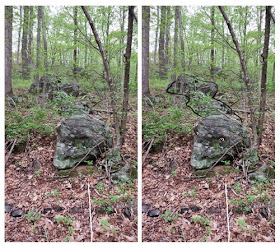




.jpg)




.jpg)


